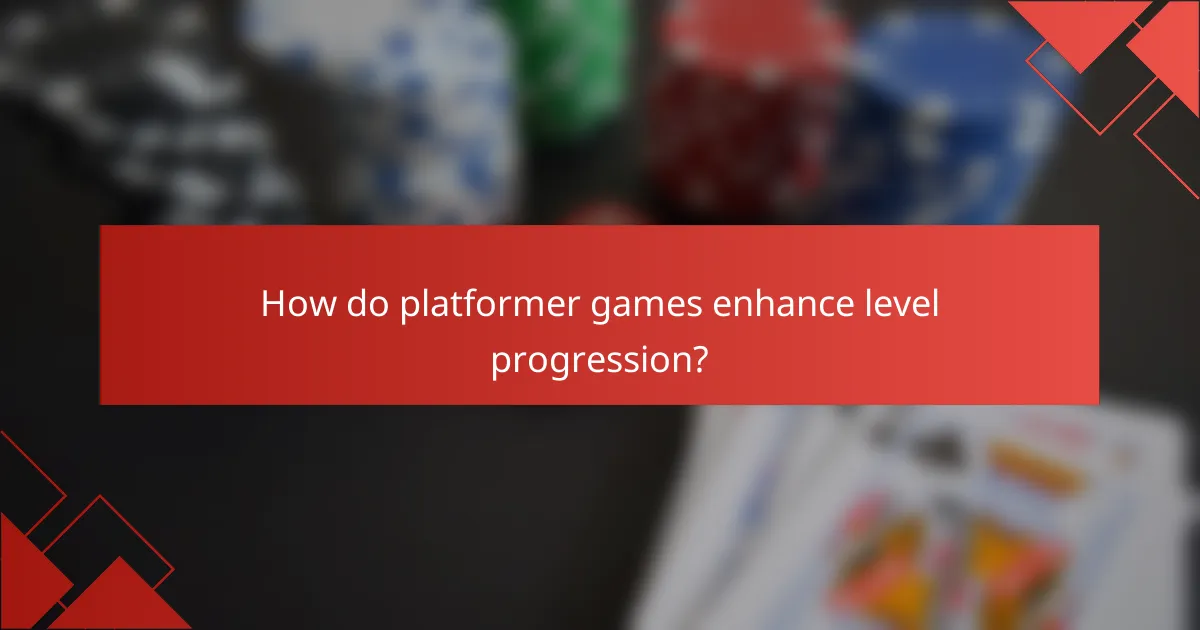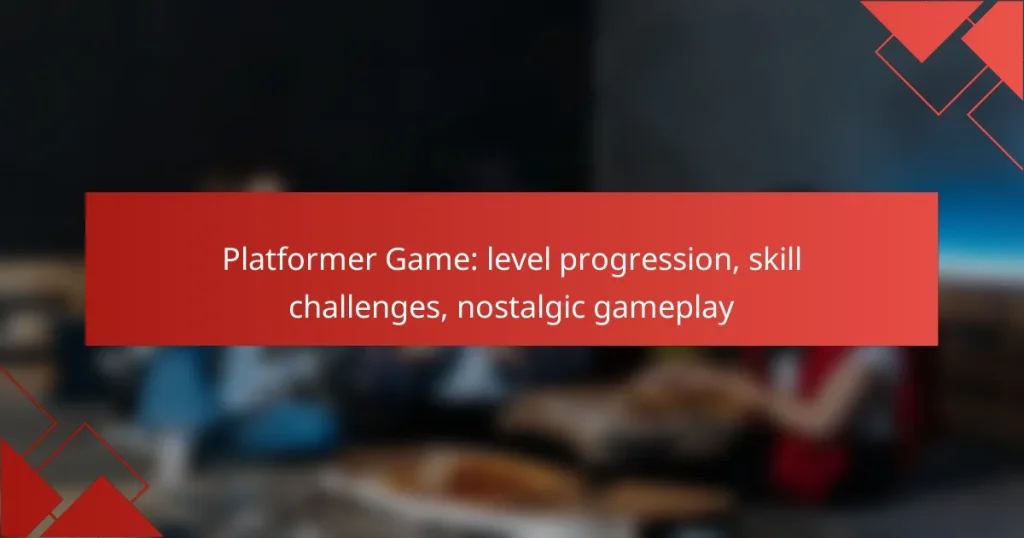Platformer games captivate players by offering a structured level progression that gradually ramps up challenges and introduces new mechanics, fostering skill development and a rewarding sense of achievement. Players face various skill challenges, such as timing-based jumps and obstacle navigation, which test their reflexes and strategic thinking. Additionally, the nostalgic gameplay evokes cherished memories of classic gaming, enhancing player engagement and satisfaction.

How do platformer games enhance level progression?
Platformer games enhance level progression by gradually increasing challenges and introducing new mechanics that keep players engaged. This structured approach allows players to develop their skills while experiencing a sense of achievement as they advance through the game.
Incremental difficulty increases
Incremental difficulty increases are essential in platformer games, as they help players build confidence and skills progressively. Levels often start with simple obstacles and gradually introduce more complex challenges, such as moving platforms or timed jumps. This method ensures that players are not overwhelmed and can adapt to new gameplay elements.
For example, a typical level might begin with static platforms before introducing enemies or environmental hazards. This progression allows players to master basic mechanics before facing tougher scenarios.
Unlockable abilities
Unlockable abilities play a crucial role in enhancing level progression in platformers. As players advance, they often gain new skills or power-ups that enable them to tackle previously inaccessible areas or challenges. These abilities can range from double jumps to temporary invincibility.
For instance, a player might unlock a wall-jump ability after completing a specific level, allowing them to explore new paths and discover hidden secrets. This not only adds depth to gameplay but also encourages exploration and replayability.
Dynamic environments
Dynamic environments significantly contribute to level progression by creating varied gameplay experiences. In many platformers, levels may change in real-time, such as platforms collapsing or new pathways opening up based on player actions. This keeps players on their toes and adds excitement to the gameplay.
For example, a level might feature a rising tide that forces players to move quickly, or shifting platforms that require precise timing. Such dynamics challenge players to adapt their strategies and enhance their overall skills.
Player feedback systems
Effective player feedback systems are vital for guiding progression in platformer games. These systems provide immediate responses to player actions, such as visual cues or sound effects, which help players understand the consequences of their decisions. Positive reinforcement, like rewarding animations or sound effects upon completing a challenge, can motivate players to continue progressing.
Additionally, clear indicators of success or failure, such as checkpoints or score displays, help players gauge their performance. This feedback encourages them to refine their skills and strive for improvement as they navigate through increasingly difficult levels.

What skill challenges are common in platformer games?
Common skill challenges in platformer games include timing-based jumps, obstacle navigation, and enemy encounters. These elements test players’ reflexes, strategic thinking, and adaptability, often requiring practice to master.
Timing-based jumps
Timing-based jumps require players to execute jumps at precise moments to clear gaps or land on moving platforms. Mastering this skill often involves understanding the rhythm of the game and anticipating platform movements.
Players should practice timing their jumps to avoid falling or missing platforms. A common tip is to focus on visual cues, such as the position of platforms or the character’s animation, to improve accuracy.
Obstacle navigation
Obstacle navigation involves maneuvering through various environmental hazards, such as spikes, pits, and moving barriers. Each level typically introduces new obstacles that require players to adapt their strategies.
To excel in this area, players should familiarize themselves with the layout of each level and plan their movements accordingly. Utilizing power-ups or special abilities can also help in overcoming particularly challenging sections.
Enemy encounters
Enemy encounters challenge players to defeat or avoid foes while progressing through levels. Understanding enemy patterns and behaviors is crucial for successful navigation and survival.
Players can benefit from studying enemy movements to find openings for attacks or safe passages. It’s often effective to use a combination of jumping and attacking to manage multiple enemies while maintaining momentum in the game.

How does nostalgic gameplay influence player engagement?
Nostalgic gameplay significantly enhances player engagement by evoking fond memories of classic gaming experiences. This emotional connection encourages players to invest time and effort into the game, often leading to increased satisfaction and loyalty.
Retro graphics and sound
Retro graphics and sound design play a crucial role in creating a nostalgic atmosphere. Pixel art and chiptune music can transport players back to earlier gaming eras, triggering positive emotions associated with those times. Games that effectively use these elements often see higher engagement levels as players appreciate the throwback aesthetic.
For example, a platformer featuring 16-bit graphics and catchy, synthesized soundtracks can resonate with players who grew up in the 1990s. This familiarity can make the gameplay feel more inviting and enjoyable.
Familiar game mechanics
Familiar game mechanics are essential for leveraging nostalgia in platformers. Many players are drawn to games that replicate the straightforward controls and level designs of classic titles. This familiarity allows players to quickly adapt and immerse themselves in the gameplay without a steep learning curve.
Common mechanics include simple jumping, running, and collecting items, which can be found in many beloved platformers. By incorporating these elements, developers can create a sense of comfort and ease that keeps players engaged.
Homage to classic titles
Creating homage to classic titles can deepen the nostalgic experience for players. By referencing well-known games through level design, character appearances, or gameplay challenges, developers can evoke a sense of nostalgia that resonates with players. This approach can create a shared experience among players who recognize these nods to their favorite games.
For instance, a level that mimics the layout of a famous platformer can spark memories and encourage players to explore and engage more deeply. However, it’s important to balance homage with originality to avoid feeling derivative.

What are the best platformer games in the UK?
The best platformer games in the UK include titles that offer engaging level progression, skill challenges, and a nostalgic gameplay experience. These games are celebrated for their design, mechanics, and the joy they bring to players of all ages.
Super Mario Odyssey
Super Mario Odyssey is a critically acclaimed platformer that combines classic gameplay with innovative mechanics. Players control Mario as he travels across various kingdoms, collecting Power Moons to rescue Princess Peach from Bowser.
The game features a unique hat mechanic, allowing Mario to capture and control different characters and objects, which adds depth to the gameplay. With its vibrant graphics and diverse environments, Super Mario Odyssey appeals to both new and veteran players.
Celeste
Celeste is a platformer that focuses on precision and skill, challenging players with its tight controls and intricate level design. The game tells the story of Madeline as she climbs the titular mountain, facing both physical and emotional obstacles.
With its pixel art style and a moving narrative, Celeste offers a blend of nostalgia and modern gameplay. Players can expect to encounter a variety of skill challenges that require quick reflexes and problem-solving abilities.
Hollow Knight
Hollow Knight is a platformer that combines exploration with combat in a beautifully crafted world. Players navigate the hauntingly atmospheric Hallownest, battling enemies and uncovering secrets as they progress through the game.
The game emphasizes level progression through its Metroidvania style, where players gain new abilities that unlock previously inaccessible areas. Hollow Knight’s intricate design and challenging gameplay make it a standout title in the platformer genre.

What criteria should be considered when selecting a platformer game?
When selecting a platformer game, consider gameplay mechanics, art style, and community feedback. These elements significantly influence the overall experience and enjoyment of the game.
Gameplay mechanics
Gameplay mechanics are crucial in platformer games, as they dictate how players interact with the game world. Look for features like character movement, jumping physics, and level design that encourage exploration and skill development. A well-balanced difficulty curve can enhance player engagement by gradually introducing new challenges.
Consider games that offer a variety of mechanics, such as wall-jumping or power-ups, which can add depth to the gameplay. Avoid titles that rely solely on repetitive actions, as they may lead to player fatigue.
Art style
The art style of a platformer game can evoke nostalgia and enhance the overall atmosphere. Whether opting for pixel art, hand-drawn graphics, or 3D environments, the visual presentation should complement the gameplay mechanics. A cohesive art style can create a memorable experience that resonates with players.
Look for games that utilize color palettes and design elements that align with the intended mood. For example, vibrant colors may suit a lighthearted adventure, while darker tones might fit a more serious narrative. Ensure that the art style is not just visually appealing but also functional, aiding in gameplay clarity.
Community feedback
Community feedback plays a vital role in the longevity and quality of a platformer game. Engaging with player reviews and discussions can provide insights into the game’s strengths and weaknesses. Pay attention to comments regarding level design, difficulty, and overall enjoyment.
Participating in forums or social media groups can also help gauge the game’s reputation and discover hidden gems. Be cautious of games with overwhelmingly negative feedback, as they may indicate poor design choices or unfulfilled promises. Look for titles that have a supportive community, as this can enhance your gaming experience through shared tips and strategies.

What emerging trends are shaping platformer games?
Emerging trends in platformer games include the integration of VR technology and cross-platform play, which significantly enhance player engagement and accessibility. These innovations are reshaping how players experience classic gameplay while introducing new challenges and opportunities for interaction.
Integration of VR technology
The integration of VR technology in platformer games allows players to immerse themselves in a three-dimensional environment, offering a unique perspective on gameplay. This trend enhances the sense of presence, making players feel as though they are physically part of the game world.
Developers are focusing on creating intuitive controls that leverage VR capabilities, such as motion tracking and hand gestures. For instance, players can jump, climb, and interact with objects in a more natural way, which can increase the difficulty and enjoyment of skill challenges.
Cross-platform play
Cross-platform play is becoming increasingly common in platformer games, allowing players on different devices to compete and cooperate. This trend breaks down barriers between gaming communities, enabling a larger player base and fostering a more vibrant online environment.
When implementing cross-platform functionality, developers must consider compatibility issues and balance gameplay to ensure fairness across platforms. For example, a game that runs on both consoles and PCs may need to adjust control schemes and difficulty levels to accommodate varying player experiences.


